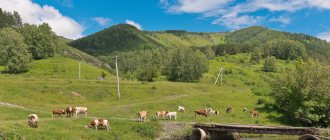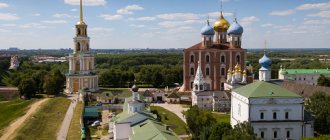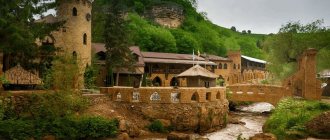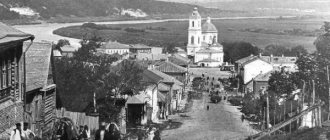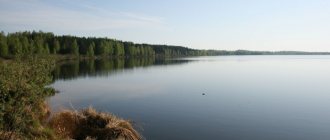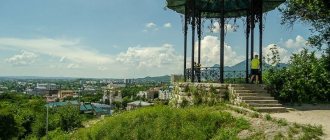How rich the Tver region is in ancient cities! One of these cities is Vyshny Volochek - small, dusty, with a strange name and interesting history.
About 46 thousand people live in Vyshny Volochyok. Its small size and convenient location on the route between Moscow and St. Petersburg make the city an ideal weekend getaway.
Despite (or perhaps thanks to) the small budget, a lot of stone and wooden buildings from the late 18th – early 20th centuries have been preserved in Vyshny Volochyok. However, the first system of locks and water canals in Russia, built under Peter I, is of particular interest to tourists. It is thanks to this abundance of water canals that the cute nickname “Little Venice” has firmly established itself behind Vyshny Volochok.
What to see in Vyshny Volochyok in one day
First, let's talk about the most important attractions of the city that you need to visit first.
Epiphany Cathedral
- Address: Ostashkovskaya, 2.
Surviving drawings and documents indicate that this cathedral was built in 1748. Over the centuries, it changed its architectural appearance: at the beginning of the 19th century, the old building was demolished and a new one was erected, in the then popular Empire style. But fifty years later, fashion changed and it was rebuilt again, this time inspired by Byzantine architecture.
The latest version of the Epiphany Church has reached our time: white stone walls, round bell towers and traditional golden domes with crosses. In the 30s The cathedral was closed, but not destroyed; its premises were used as warehouses. Most churches returned to their activities in 1980-1990, while the Epiphany Church was reopened immediately after the war.
Today it is the religious center of the city and the main attraction of Vyshny Volochek. Famous miraculous icons and relics of saints have been within the walls of the cathedral more than once. As for his own iconostasis, it consists of valuable icons from the 17th-18th centuries. There is a small park around. A cluster of deciduous trees hugs the building and from the street only the domes soaring into the sky are visible.
City Garden
- Address - st. Podbelsky.
The City Garden is a large park within the city. It is popular among both tourists and locals. It is a center for active recreation: on its territory there are rental points for bicycles, scooters and roller skates, as well as children's rooms and attractions. The park also has a football field, which is used as a skating rink in winter.
Photo: © https://fotki.yandex.ru/users/desiderit/
There are stalls with sweets and soft drinks along the walking paths. Walking terraces lead through green alleys and flowering gardens. The park is decorated with fountains and plaster sculptures in the form of lions, turtles and hippos. In the summer, various holidays, sports and entertainment events with intellectual and active games for children are held here.
Museum "Russian felt boots"
- Address – Moskovskaya, 76/37.
For a resident of Russia, felt boots are an ordinary item of clothing, in which there is nothing surprising. However, in Vyshny Volochyok there is a museum dedicated to these winter shoes. The fact is that this is the only city where felt boots were felted by hand, according to Russian traditions, and not using machines and machines.
The museum's exhibition demonstrates equipment for making felt boots and tells how the felting technique has changed and improved over time.
The exhibition halls of this attraction have a cozy, sincere atmosphere. And the best part is that in the museum you can not only admire the elegantly decorated felt boots, but also order a product based on your own sketch, with an original design not found anywhere else.
Ryabushinsky's dacha
A wooden building in Art Nouveau style that once belonged to a wealthy merchant, is now in very poor condition. But you can also recognize the Art Nouveau style in which the building with its outbuilding was built. The building was scheduled for demolition, but activists and local historians managed to defend it and perhaps soon restoration will begin in the house.
Temples and monasteries
In addition to the cathedral already described, there are many Orthodox churches and monasteries in Vyshny Volochyok. They were all built at different times and each has its own, unique history.
Kazan Monastery
- Address - st. Red Town.
The Kazan Convent was founded in 1881 and consecrated in honor of the icon of the Mother of God. The initiative to build the monastery belonged to Prince Putyatin, he allocated money for construction and wished that the abbess and novices would live and serve according to strict monastery traditions, implying strict fasting, intensive prayer services and complete seclusion.
The main one in the complex is the Cathedral of the Kazan Icon of Our Lady, built in 1882 according to the design of the famous Russian architect Alexander Kaminsky. The building is made in the Byzantine style. Looking at the intricate design of the facade, you can feel the love and imagination with which the talented master approached the work. Despite its massiveness, the cathedral looks airy and light, like a heavenly cloud.
The architectural ensemble of the monastery also consists of several other buildings of a religious nature, among them:
- Temple of the Andronicus Icon of the Mother of God of the late 19th - early 20th centuries.
- The Temple of Sirin and Neonila is one of the first buildings of the monastery, erected in 1880.
- Overhead chapel.
- Church of the Bogolyubskaya Icon of the Mother of God.
- Residential cells of nuns and refectory chambers.
Also of interest is the chapel over the burial place of Elder Lyubushka Susaninskaya, a blessed nun of the monastery who died in 1997 at the age of 87. There is a memorial house and prayer room next to her grave.
Since its foundation, the monastery ceased to function only during the reign of Soviet power. In the 80s the institution was returned to the Tver diocese and, after extensive renovations, reopened its doors to a new generation of novices.
The servants of the monastery honor the memory of Prince Putyatin and carry out his will, observing the strict customs of the monastery canons. The nuns live in isolation and even fellow believers do not dare to disturb their peace, so visits to the Orthodox attraction are limited, and there are no excursions on its territory. The only accessible building is the Kazan Cathedral.
Alexander Nevsky Church
- Address: Paris Commune, 27.
In 1866, Emperor Alexander II almost became a victim of assassination. As the monarch was getting into the carriage, a bullet whistled over his head. The would-be assassin aimed at the sovereign's temple, but a peasant standing nearby pushed the shooter and he missed. Twenty years later, in honor of this event, a small church was erected, consecrated in the name of Alexander Nevsky.
The modest building is built of white stone in an eclectic style, with a small silver dome crowning the roof. In former times, there was a wooden bell tower next to it, which was burned down during the Soviet years. In 1970, the church parish was expanded: the main building was connected to several nearby buildings.
Assumption Church
- Address - Kommunarov, 1/2.
Founded in 1868, the church became one of the brightest churches in the Tver region. The complex consists of two buildings of different architectural styles, but the same in terms of color scheme: the walls are painted dark red and decorated with white ornaments. The buildings of the temple and the almshouse communicate with each other through a vestibule, which smoothly turns into a bell tower with a hipped roof.
In 1929, the Church of the Assumption of the Blessed Virgin Mary was looted, but the building itself survived and was used first as a warehouse, and later as a military hospital. The religious activities of the temple resumed in 1993, by which time the building had become very dilapidated and required major repairs, but even this could not restore it to its former beauty. However, the church is in great demand among parishioners and tourists.
Magistrate's Building
The current building of the city library once housed the magistracy. Now the building looks like a single whole, but originally, in the 17th century, it was two separate buildings. Then a third one with a tower was built between them. The builders did everything to organically integrate the new building and create a single complex. To date, it has been possible to preserve this original appearance from the outside and inside of the building.
Museum Vyshny Volochek
There are very few museums in Vyshny Volochyok, but their exhibitions are famous for their originality and will appeal not only to adults, but also to children.
Glass Museum
- Address: Muslim Magomaeva, 17.
The museum is dedicated to the glass factory, which closed several years ago. The specificity of production was products made of colored glass, so the exhibition is full of bright exhibits that are regarded as works of artistic and aesthetic art. Here you can see painted vases, various cutlery, figurines and figurines depicting people, animals and nature.
Museum of Local Lore
- Address - Kazansky Avenue, 63/65.
A visit to the local history museum is a must for anyone who wants not only to get acquainted with modern Vyshny Volochok, but also to learn about its past. The exhibition here tells in detail about the origins of the city, the construction of its main temples, the fates of legendary personalities and clearly shows how the townspeople lived in different eras.
Numerous exhibits will serve as illustrations for this story: archaeological artifacts, preserved household items, personal belongings, letters and photographs of people unforgotten by their descendants. The museum's collection was assembled in 1932 and since then not a single one of its elements has been lost. On the contrary, it continues to replenish.
Museum of Local Lore
Next to the drama theater, a museum building was built from the same red brick, the funds of which were formed after the revolution and today contain over 30 thousand exhibits. The exhibitions eloquently tell about the past of the city, from its very origins to the present.
Architectural monuments
The clock does not stop ticking, generations are replaced by generations. Only stone structures erected years and centuries ago remain unshakable. They are like traces that people leave on the canvas of time. Who inscribed their name on the streets of Vyshny Volochok?
Serdyukov Estate
- Address - Vanchakova line, 31.
On the outskirts of the city there is a unique manor in the Baroque style. Its owner was Mikhail Serdyukov, a merchant and outstanding engineer of the 17th century. This is the only building from the time of Peter the Great that has survived to this day. In previous years, the estate was surrounded by a luxurious park, and there was a distillery nearby, of which now only ruins remain. But the mansion itself and the outbuildings of the stables have been preserved quite well.
A distinctive feature of the estate is the absence of a private church, which in that era seemed unusual and even reprehensible. The fact is that Mikhail Serdyukov, a Mongolian by origin, did not favor Orthodoxy. Despite this, he had friendly relations with Peter I. The Emperor often stayed at the estate and even added a small touch to its picturesque picture - he planted a barberry bush, which is still blooming.
Kharlamov's House
- Address: Vagzhanova street, 7/29.
The small wooden hut, built at the beginning of the 20th century, became famous for the fact that the famous composer, opera and pop singer Muslim Magomayev lived under its roof. The one-story house is striking with elaborate carvings adorning its eaves, window frames and porch. The finely crafted patterns are preserved in perfect condition. The name of the master who created all this beauty, unfortunately, is unknown.
Nerucheva Estate
- Address – Leningradskoye Shosse, 3/2.
This estate appeared in Vyshny Volochyok in 1798, its owner was the noblewoman Marfa Nerucheva. Later it was bought by a wealthy merchant Alexey Sokolov, which is why the estate is sometimes called the “Sokolov House”.
The three-story mansion was distinguished by its beauty and luxury. Its walls were painted crimson, the window frames were decorated with stucco, and four marble columns stood at the main entrance.
Under Soviet rule, the estate fell into disrepair and has not been restored since then. The building is completely abandoned - all that remains of the interior decoration are walls with sparse fabric covering, ruins of fireplaces and the remains of stucco on the ceilings.
Ryabushinsky's dacha
- Address: Nagornaya street.
The mansion of the merchant Ryabushinsky, built in the 19th century in Art Nouveau style, is located on Sadovaya Square. This is a two-story stone building with wood trim elements. Despite its dilapidated appearance, the house has retained its former diversity and originality. Above each window there is a narrow canopy with jagged carvings, and a hip roof hangs over the extensive porch. Inside the dacha, luxurious interiors have been preserved: massive doors, high ceilings with traces of stucco molding and wide staircases with twisted railings.
Public Offices and Magistrate Building
- Address: Ostashkovskaya, 2.
In 1780, architect P.R. Nikitin erected a complex of administrative buildings. According to his idea, the buildings were supposed to stretch along Tveretskaya embankment, located at an equal distance from each other.
However, in the middle of the 19th century, Nikitin’s plan was violated - the buildings were connected by building a brick house with an adjacent fire tower between them. However, the changes made did not distort the harmonious appearance of the complex: all its constituent buildings have the same architectural decor. The windows are framed with simple geometric frames and rest on narrow cornices.
The entrances are marked with ribbed arches, and along the pavement there are well-groomed bushes, trimmed to form a cube. The building is painted white and green and functions as the county library and fire station.
Travel Palace
- Address – Ostashkovskaya, 3/7.
Travel palaces were intended for members of the Royal Family and were built in several settlements located along the road from Moscow to Petrograd (present-day St. Petersburg ). The long three-story palace of Vyshny Volochok was reconstructed many times and at the beginning of the 19th century it was given features characteristic of the classicism style.
The furnishings of the palace corresponded to the habits and needs of its owners. The spacious rooms housed personal chambers, guest rooms, offices, living rooms, dining rooms and reception halls.
Luxurious interiors, jewelry and personal belongings of the imperial family were looted during the years of revolution and war. Today, in the building of the former palace complex there is a secondary school, which, although it does not deserve to be a landmark, still deserves to look at its structure.
Map
Attractions marked on the city map:
Beishlot on Tsna
Address: The dam is located in a picturesque location near Turgenevsky Lane. You can also approach it from Razin Street along Komsomolsky Lane.
This two-span passable dam was built in 1720 to maintain the required water level for ships to pass along the Tsna. The beishlot was reconstructed many times, but its appearance remained almost unchanged. The water discharge system is still in use.
Channels
Address: — You can get to the Tveretsky Canal from Kazansky Prospekt through a construction site and an abandoned bathhouse. — The Tsninsky Canal is easy to find if you go down from the Petersburg Bridge or walk from the city center from Karl Marx Street, Uritsky Street to the Vanchakov Line.
The water network includes two canals: Tveretsky and Tsninsky. Both of them are in disrepair. An embankment that has not been restored for a long time runs along the Tsninsky Canal, which causes a depressing impression. The only thing pleasing to the eye is the canal bed, lined with granite slabs.
Monuments and sculptures of the city
Walking along the streets of Vyshny Volochok, you can see many monuments dedicated to historical figures and people of art.
Monument to Peter I and Serdyukov
- Address: Privokzalnaya Square.
In his sculpture, architect Yuri Zlotya captured the moment when hydraulic engineer Mikhail Serdyukov showed the emperor a drawing of the future water system of Vyshny Volochok. Peter is depicted in a royal uniform with a sword on his side and a cocked hat on his head. He looks carefully at the unfolded scroll and waves his right hand, approving Serdyukov’s idea.
Bronze sculptures 2 meters high are located on a stone pedestal. The grand opening of the unusual memorable landmark of the city took place in September 2006. The monument is maintained in good condition, there are no signs of corrosion or graffiti.
Monument to Catherine II
- Address – Kazansky Ave., 20.
Another work by Yuri Zloty in honor of the monarch, who contributed to the development of the locality. In 1770, Empress Catherine II gave Vyshny Volochok the status of a city and its own coat of arms. A monument was erected in memory of this event.
Catherine proudly sits on a throne, the armrests of which are decorated with eagle heads, and the legs with clawed paws. The ruler herself is dressed in ceremonial attire, with a robe made of ermine wool falling from her shoulders. In her right hand, Catherine holds a scepter, and with her left hand she holds out a crown - a symbol of the decree on the founding of the city of Vyshny Volochyok.
The three-meter sculpture is installed on a granite platform and a faceted pedestal.
Lenin monument
- Address: Kazansky Avenue, 18.
Monument to V.I. Lenin was installed in the central part of the city in 1968. The figure of the leader is carved from granite and placed on a high pedestal. Vladimir Lenin is depicted standing, his right hand is extended forward, as if he is addressing the people, and in his left he is clutching the cap that has been removed from his head. Many of the city’s sculptures have suffered from vandalism, but this monument is intact and well-maintained.
Memorial to Venetsianov
- Address: Venetsianovsky Square.
The memorial to artist Alexei Venetsianov was created in 1980 by sculptor Oleg Komov. The landmark has become a symbol of the city and is often found on souvenir postcards and guidebooks.
Venetsianov stands on a rectangular stone pedestal, behind him is a blank canvas, in his hands is a palette and a brush, and his faithful wife and assistant Marfa is sitting on a bench next to him. She is breastfeeding a baby.
The artist spent 30 years of his life in Vyshny Volochyok and during this period he painted a huge number of paintings, many of which received all-Russian fame, and opened an art school where children and adults could learn painting from masters.
The monument is installed opposite the art gallery with paintings by Venetsianov.
Monument to Lermontov
- Address: Ekaterininskaya, 20.
The monument to the great Russian poet and prose writer Mikhail Lermontov is located at the intersection of Ekaterininskaya and Krasnye Pechatnikov streets. This is a perfect copy of the monument erected in Lermontov’s homeland - in Tarkhany, near Pyatigorsk , where the figure’s last duel .
Lermontov stands on a low pedestal with his hands behind his back. He is dressed in a military uniform, the kind worn by officers of the early 19th century.
There is no exact information about the author of the sculpture and the date of creation. There is a version that this is the work of sculptor Boris Zotov, who lived in the city in the late 1950s. The monument is practically not cared for; several years ago, Lermontov’s nose was broken off, and the damage was never repaired.
Museum "Russian felt boots"
It is believed that the felted shoe factory operating in the city is the only one in the country today. There is a felt felt museum at the factory, which displays equipment for felting wool. Here you can see paintings made of felted wool, toys and souvenirs, and an incredible number of felt boots of all colors and sizes.
Natural attractions
The banks of the Tsna River, on which the city stands, are famous for their beautiful views and untouched wildlife. Walking through green parks and forests is a pleasure.
Tsna River
- Coordinates: 57.577457, 34.555277.
The embankments of Tsna are not equipped for tourists. There are no changing cabins, sun loungers, souvenir shops or railings for entering the water. But the lack of amenities doesn't dampen weekends by the river. Walking through the forests, swimming in specially designated areas and areas for lighting fires - this is more than enough for outdoor recreation. Thanks to the long coastline, it is never crowded due to the crowd of tourists and you can always find a quiet, secluded corner.
Tekstilshchikov Park
- Coordinates: 57.580499, 34.552627.
A wonderful natural place in the city center, which, however, is not at all well-kept. The park is located on two islands surrounded by canals and a river. There are several bridges leading here where you can take good photos. The place is very well located, but for some reason no one wants to improve it.
Beishlot
- Coordinates: 57.581030, 34.546900.
Also known as the Verkhne-Tsninskaya dam. Beishlot was designed by Mikhail Serdyukov and installed in 1720. Thanks to the dam, many reservoirs and artificial lakes were formed, which later supported navigation along the Tsna canals.
In 1786, Beishlot was improved: its structure was strengthened, and the wooden foundations were replaced with granite ones. Created in the 18th century, the dam is still in operation today. There is a log bridge across it, and on the banks there are gazebos and recreation areas.
Tsninsky Canal
- Coordinates: 57.587895, 34.546825.
The Tsna Canal was dug in 1722. Its main purpose was to straighten the Tsna channel. The length of the canal reaches 1 km, and the depth is 300 m. Park areas with walking paths, comfortable benches and bridges across the canal stretch along the reservoir. The parks are kept clean; pollution of forests and water is punishable by a fine.
Lake Mstino
- Coordinates: 57.670493, 34.504074.
One of the largest natural lakes in the Tver region. Several rivers flow into it - Tsna, Msta, Rudinka and Rundyovka. The coastal landscape is varied, with forests, swamps, hills and plains.
Mstino is the most important recreational center of Vyshny Volochok. On its territory there are sanatoriums and recreation centers; the most prestigious are Serebryaniki, Valentinovka and Academic Dacha, operating since 1884.
Vyshnevolotskoye Reservoir
- Coordinates: 57.563677, 34.446160.
The waters of the reservoir fill the valleys of the Tsna and Shlina rivers. The creeks are unsuitable for swimming due to large accumulations of algae. But fishing is very popular here. Fishing on the reservoir brings good catches of perch, bream and crucian carp, and occasionally pike are caught.
Vyshnevolotsk water system
This water system began with the construction of the first canal by the Dutch and with the further continuation of the construction of a whole network of canals that made it possible to water the area, create a reservoir and build a dam with locks allowing ships to move up and down.
Where else to go in Vyshny Volochyok
Ruins of the city bath
- Address: Tveretskaya embankment.
This object is located at the point where the Strotveretsky Canal merges with the Tsna River, on Tveretskaya Embankment. The place can hardly be called a full-fledged attraction - rather, it is an ordinary abandoned place from the past, but if you are a fan of seeing something unusual, then you will definitely appreciate these ruins.
Drama Theater
- Address – Kazansky Ave., 20.
And although Vyshny Volochek is a small town, it has its own theater, which is open every day and shows interesting theatrical performances to the townspeople. The drama theater is located near the Museum of Local Lore and the monument to Catherine II. As residents of V. Volochok say, the facility allows you to relax, see an interesting performance or performance that children will enjoy.
Don't miss the sights of other cities in the Tver region:
- Kimr, Ostashkova, Staritsa,
- Likhoslavl, Kalyazin, Bologoe,
- Rzhev, Konakovo, Toropets, Torzhok,
- Bezhetsk, Kashin and Tver.
Using the example of Vyshny Volochok, it becomes obvious that even small and modest towns can be of tourist interest and are able to offer a varied cultural program to their guests, educational attractions and must-see places. Visiting historical monuments, ancient cathedrals and walks through natural spaces not only contribute to a good time, but also broaden your horizons, which, undoubtedly, is one of the main goals of any trip.
Glass Museum
This museum was created at a now defunct glass factory. The collection of exhibits includes over four thousand items, the oldest of which dates back to 1870. The stars of the Moscow Kremlin were made at this glass factory. The Moscow metro lamps are made here.
Vyshnevolotskoye Reservoir
The Vyshnevolotsk reservoir recently turned 300 years old. Created according to the plan of Peter the Great and merchant Mikhail Serdyukov to create and preserve navigation and water supply to the settlements surrounding the reservoir.
The last reconstruction of the reservoir structures was carried out in 1951. The area of the reservoir is now more than 100 square kilometers.
